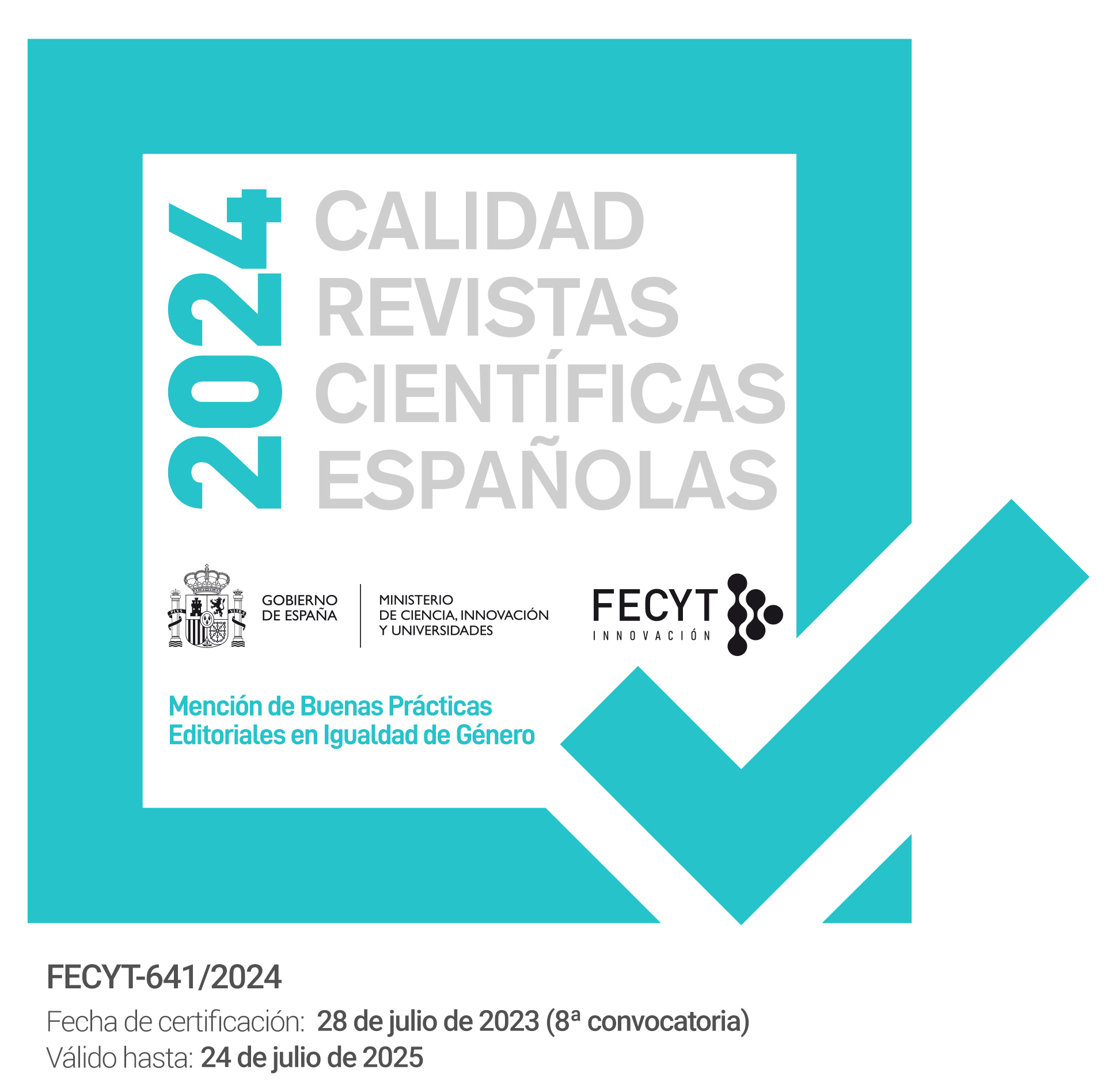Bergamín, pasajero español en México (1939-1946)
DOI:
https://doi.org/10.12795/PH.2009.v23.i01.06Keywords:
exile, literay modernity, intertextuality, El PasajeroAbstract
This article examines the works of Bergamín during the period 1939-1946, transcending as far as possible the critical and tempo- rary framework given by traditional literary history. In this way, despite his historical situation in exile, we can show their continu- ity and also relate Bergamín’s literature and his poetic thought to the most emblematic forms and subjects of the literary modernity. At the same time, we see in these works thematic and formal con- stants of the Spanish literature during the 19th and 20th centuries.
Downloads
References
REFERENCIAS BIBLIOGRÁFICAS CITADAS DE BERGAMÍN
Detrás de la cruz. Terrorismo y persecución religiosa en España, México, Séneca, 1941.
El cohete y la estrella. La cabeza a pájaros, José Esteban (ed.), Madrid, Cátedra, 1981.
El Pasajero. Peregrino español en América, Nigel Dennis (ed.), A Coruña, Edición do Castro, 2005.
La voz apagada. Dante dantesco y otros ensayos, México, Edit. Central, 1945.
“Prólogo-epílogo-apostillas a La niña guerrillera”, Renacimiento (Las literaturas del exilio republicano de 1939), 27-30 (2000), pp. 103-109.
REFERENCIAS BIBLIOGRAFICAS
Agamben, G., “Du dandy au démonologue”, en José Bergamín, Paris, Edition du Centre Pompidou, 1989, pp. 21-35.
Ayala, F., “La cuestionable literatura del exilio”, Los Cuadernos del Norte, 8 (Ju-lio-Agosto 1981), pp. 62-67.
_____, “Para quién escribimos nosotros” Renacimiento (Las literaturas del exilio republicano de 1939), 27-30 (2000), pp. 99-101.
Caudet, F., El exilio republicano en México. Las revistas literarias (1939-1971), Madrid, Fundación Banco Exterior, 1992.
Ciplijauskaité, B., “José Bergamín, gran titulista y prestidigitador”, en José Ber-gamín tra avanguardia e barocco, a cura di Paola
Ambrosi, Edizioni ETS, Pisa, 2002.
Dennis, N., (ed.), José Bergamín, Don Lindo de Almería, Valencia, Pre-Textos, 1988.
_____, “Cultura y exilio: Bergamín y la primera edición de las Obras completas de Antonio Machado (México, 1940)”, Revista de Occidente 166 (1995), pp. 100-112.
_____, “José Bergamín frente a México y los mexicanos (1939-1945)”, en El exilio literario español de 1939: Actas del Primer Congreso Internacional (Be-llaterra, 27 de noviembre-1 de diciembre de 1995). Vol. 1, 1998, pp. 229-236.
_____, “José Bergamín: teoría y práctica del exilio” en Sesenta años después. Las literaturas del exilio republicano de 1939, Actas del II Congreso Internacional, Vol. 2 Barcelona, Gexel, 2000, pp. 31-47.
Fernández Sánchez-Alarcos, R., “La poesía humanizada de Bergamín y algo más sobre Los Filólogos”, Cuadernos Hispanoamericanos, 514-515 (1993), pp. 221-226.
_____, “Oralidad y literatura: la crisis de la novela realista”, Pandora. Ora-lités, 2 (2002), pp.141-150.
_____, “La novela del periodo isabelino al servicio de las controversias polí-ticas, sociales y religiosas”, en Cinta Canterla (ed.) Nación y
Consti-tución. De la ilustración al Liberalismo, Sociedad de estudios del si-glo XVIII- Junta de Andalucía, Sevilla, 2006, pp. 365-374.
Gadamer, H.-G., La actualidad de lo bello, Barcelona, Paidós/ICE-UAB, 1991.
Gurméndez, C., prólogo a José Bergamín, El pozo de la angustia, Barcelona, Anth-ropos, 1985.
Gutiérrez Girardot, R., Modernismo, Barcelona, Montesinos, 1983.
Largo Carballo, A., América en la conciencia española de nuestro tiempo, Madrid, Trotta, 1997.
Mainer, J.-C., La corona hecha trizas (1930-1960). Una literatura en crisis, Barce-lona, Crítica, 2008.
Pastor Pérez, M. de L., “La edición de las obras de Machado en editorial Séneca (México, 1940), en Manuel Aznar Soler (ed.), Escritores, editoriales y re-vistas del exilio republicano de 1939, Sevilla, Gexel-Renacimiento, 2006, pp. 565-572.
Paz, O., “Poesía e historia: ‘Laurel’ y nosotros”, en Obras completas II, Barcelona, Galaxia Gutenberg/Círculo de lectores, 2000, pp. 722-779.
Penalva, G., Tras las huellas de un fantasma, Madrid, Turner, 1985.
Salaün, S., “La poesía española en el exilio o la continuidad (1938-1955)”, en Ma-nuel Aznar Soler (ed.), Sesenta años después. Las literaturas del exilio re-publicano de 1939, Actas del II Congreso Internacional, vol. 1, Barcelona, Gexel, 2000, pp. 579-607.
Santa María Fernández, T., “Bergamín, interlocutor con el pasado”, en Manuel Az-nar Soler (ed.), Sesenta años después. Las literaturas del exilio republica-no de 1939, Actas del II Congreso Internacional, vol. 2, Barcelona, Gexel, 2000, pp. 133-143.
_____, “Lope y Bergamín por Los tejados de Madrid”, en Manuel Aznar Soler (ed.), Escritores, editoriales y revistas del exilio republicano de 1939, Se-villa, Gexel-Renacimiento, 2006, pp. 1121-1127.
Santiáñez, N., Investigaciones literarias. Modernidad, historia de la literatura y modernismos, Barcelona, Crítica, 2002.
Santonja, G., Al otro lado del mar. Bergamín y la Editorial Séneca (México 1939-1949), Barcelona, Círculo de Lectores/Galaxia Gutenberg, 1997.
_____, Los signos de la noche. De la guerra al exilio. Historia peregrina del libro republicano entre España y México, Madrid, Castalia, 2003.
Travis, C. M., “Negotiating Public Intellectualism: Pablo Neruda among the Mexi-can Poets (1940-1943)”, Revista Hispánica Moderna, LV (2002) nº 1, pp. 94- 109.
Zambrano, M., Filosofía y pensamiento, México, Fondo de Cultura Económica, 2006.
Detrás de la cruz. Terrorismo y persecución religiosa en España, México, Séneca, 1941.
El cohete y la estrella. La cabeza a pájaros, José Esteban (ed.), Madrid, Cátedra, 1981.
El Pasajero. Peregrino español en América, Nigel Dennis (ed.), A Coruña, Edición do Castro, 2005.
La voz apagada. Dante dantesco y otros ensayos, México, Edit. Central, 1945.
“Prólogo-epílogo-apostillas a La niña guerrillera”, Renacimiento (Las literaturas del exilio republicano de 1939), 27-30 (2000), pp. 103-109.
Downloads
Published
How to Cite
Issue
Section
License
The printed and electronic editions of this Journal are edited by the University of Seville Editorial, and the source must be cited in any partial or total reproduction.
Unless otherwise indicated, all the contents of the electronic edition are distributed under a license of use and distribution “Attribution-NonCommercial-NoDerivatives 4.0 International” . You can view the informative version and the legal text of the license here. This fact must be expressly stated in this way when necessary.
Authors who publish in this journal accept the following conditions:
- The author/s retain copyright and grant the journal the first publication right, and accept it to be distributed with the Creative Commons By NC ND 4.0 licence, which allows third parties to use what is published whenever they mention the authorship of the work and the first publication in this journal and whenever they do not make commercial use and reuse it in the same way.
- Authors can make other independent and additional contractual agreements for the non-exclusive distribution of the article published in this journal (e.g., include it in an institutional repository or publish it in a book) provided they clearly indicate that the work was published for the first time in this journal.
Authors are allowed and recommended, once the article has been published in the journal Philologia Hispalensis (online version), to download the corresponding PDF and disseminate it online (ResearchGate, Academia.edu, etc.) as it may lead to productive scientific exchanges and to a greater and faster dissemination of published work (see The Effect of Open Access).
- Abstract 171
- PDF (Español (España)) 56







